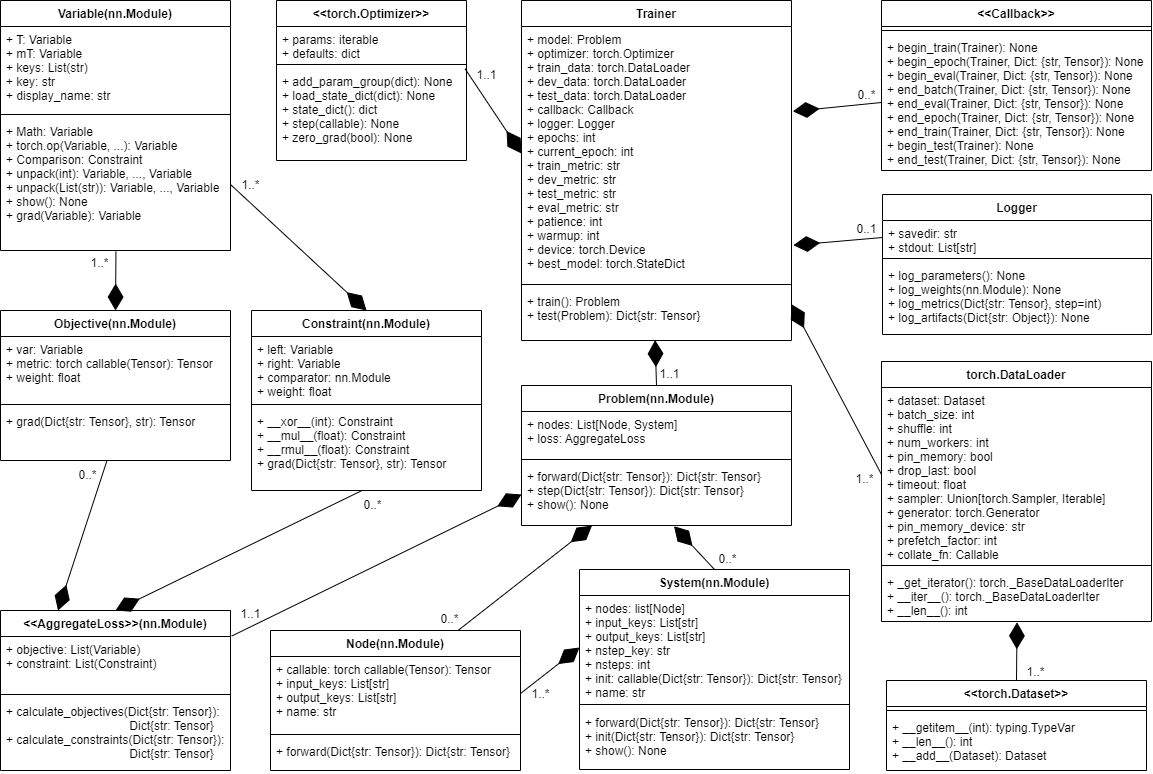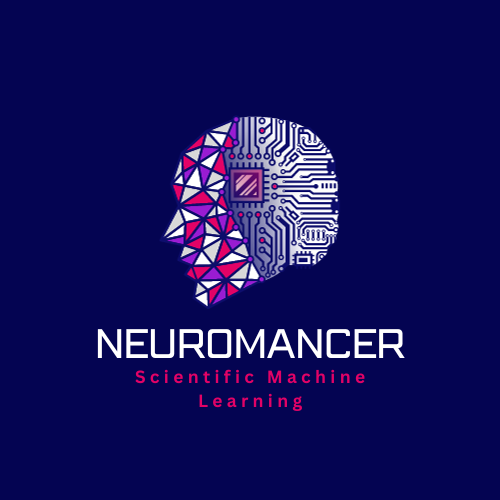Neural Modules with Adaptive Nonlinear Constraints and Efficient Regularizations (NeuroMANCER) is an open-source differentiable programming (DP) library for solving parametric constrained optimization problems, physics-informed system identification, and parametric model-based optimal control. NeuroMANCER is written in PyTorch and allows for systematic integration of machine learning with scientific computing for creating end-to-end differentiable models and algorithms embedded with prior knowledge and physics.

- User workflow simplifications: zero boilerplate code and increased modularity
- Ability for user to define custom training logic easily
- Easy support for distributed GPU training
- Weights and Biases hyperparameter tuning
Please refer to the Lightning folder and its README.
New Colab Examples:
⭐ Various domain examples, such as system identification of building thermal dynamics, in NeuroMANCER
Extensive set of tutorials can be found in the examples folder. Interactive notebook versions of examples are available on Google Colab! Test out NeuroMANCER functionality before cloning the repository and setting up an environment.
-
Part 2: NeuroMANCER syntax tutorial: variables, constraints, and objectives.
-
Part 3: NeuroMANCER syntax tutorial: modules, Node, and System class.
-
Part 1: Learning to solve a constrained optimization problem.
-
Part 2: Learning to solve a quadratically-constrained optimization problem.
-
Part 3: Learning to solve a set of 2D constrained optimization problems.
-
Part 4: Learning to solve a constrained optimization problem with the projected gradient.
-
Part 5: Using Cvxpylayers for differentiable projection onto the polytopic feasible set.
-
Part 1: Neural Ordinary Differential Equations (NODEs)
-
Part 2: Parameter estimation of ODE system
-
Part 3: Universal Differential Equations (UDEs)
-
Part 4: NODEs with exogenous inputs
-
Part 5: Neural State Space Models (NSSMs) with exogenous inputs
-
Part 6: Data-driven modeling of resistance-capacitance (RC) network ODEs
-
Part 7: Deep Koopman operator
-
Part 8: control-oriented Deep Koopman operator
Part 1: Diffusion Equation
Part 2: Burgers' Equation
Part 3: Burgers' Equation w/ Parameter Estimation (Inverse Problem)
-
Part 1: Learning to stabilize a linear dynamical system.
-
Part 2: Learning to stabilize a nonlinear differential equation.
-
Part 3: Learning to control a nonlinear differential equation.
-
Part 4: Learning neural ODE model and control policy for an unknown dynamical system.
-
Part 5: Learning neural Lyapunov function for a nonlinear dynamical system.
-
Part 1: Learning to Control Indoor Air Temperature in Buildings.
-
Part 2: Learning to Control an Pumped-Hydroelectricity Energy Storage System.
-
Part 3: Learning Building Thermal Dynamics using Neural ODEs.
-
Part 4: Data-driven modeling of a Resistance-Capacitance network with Neural ODEs.
-
Part 5: Learning Swing Equation Dynamics using Neural ODEs.
-
Part 6: Learning Building Thermal Dynamics using Neural State Space Models.
-
Part 1: Lightning Integration Basics.
-
Part 2: Lightning Advanced Features and Automatic GPU Support.
-
Part 3: Hyperparameter Tuning With Lightning & WandB
-
Part 4: Defining Custom Training Logic via Lightning Modularized Code.
The documentation for the library can be found online. There is also an introduction video covering core features of the library.
# Neuromancer syntax example for constrained optimization
import neuromancer as nm
import torch
# define neural architecture
func = nm.modules.blocks.MLP(insize=1, outsize=2,
linear_map=nm.slim.maps['linear'],
nonlin=torch.nn.ReLU, hsizes=[80] * 4)
# wrap neural net into symbolic representation via the Node class: map(p) -> x
map = nm.system.Node(func, ['p'], ['x'], name='map')
# define decision variables
x = nm.constraint.variable("x")[:, [0]]
y = nm.constraint.variable("x")[:, [1]]
# problem parameters sampled in the dataset
p = nm.constraint.variable('p')
# define objective function
f = (1-x)**2 + (y-x**2)**2
obj = f.minimize(weight=1.0)
# define constraints
con_1 = 100.*(x >= y)
con_2 = 100.*(x**2+y**2 <= p**2)
# create penalty method-based loss function
loss = nm.loss.PenaltyLoss(objectives=[obj], constraints=[con_1, con_2])
# construct differentiable constrained optimization problem
problem = nm.problem.Problem(nodes=[map], loss=loss) UML diagram of NeuroMANCER classes.
UML diagram of NeuroMANCER classes.
Consider using a dedicated virtual environment (conda or otherwise) with Python 3.9+ installed.
pip install neuromancerExample usage:
import torch
from neuromancer.system import Node
fun_1 = lambda x1, x2: 2.*x1 - x2**2
node_3 = Node(fun_1, ['y1', 'y2'], ['y3'], name='quadratic')
# evaluate forward pass of the node with dictionary input dataset
print(node_3({'y1': torch.rand(2), 'y2': torch.rand(2)}))
First clone the neuromancer package. A dedicated virtual environment (conda or otherwise) is recommended.
Note: If you have a previous neuromancer env it would be best at this point to create a new environment given the following instructions.
git clone -b master https://github.com/pnnl/neuromancer.git --single-branchconda create -n neuromancer python=3.10.4
conda activate neuromancerFrom top level directory of cloned neuromancer run:
pip install -e.[docs,tests,examples]OR, for zsh users:
pip install -e.'[docs,tests,examples]'See the pyproject.toml file for reference.
[project.optional-dependencies]
tests = ["pytest", "hypothesis"]
examples = ["casadi", "cvxpy", "imageio", "cvxpylayers"]
docs = ["sphinx", "sphinx-rtd-theme"]Before CVXPY can be installed on Apple M1, you must install cmake via Homebrew:
brew install cmakeSee CVXPY installation instructions for more details.
Conda install is recommended for GPU acceleration.
❗️Warning:
linux_env.yml,windows_env.yml, andosxarm64_env.ymlare out of date. Manual installation of dependencies is recommended for conda.
conda env create -f linux_env.yml
conda activate neuromancerconda env create -f windows_env.yml
conda activate neuromancer
conda install -c defaults intel-openmp -fconda env create -f osxarm64_env.yml
conda activate neuromancer!!! Pay attention to comments for non-Linux OS !!!
conda create -n neuromancer python=3.10.4
conda activate neuromancer
conda install pytorch pytorch-cuda=11.6 -c pytorch -c nvidia
## OR (for Mac): conda install pytorch -c pytorch
conda config --append channels conda-forge
conda install scipy numpy"<1.24.0" matplotlib scikit-learn pandas dill mlflow pydot=1.4.2 pyts numba
conda install networkx=3.0 plum-dispatch=1.7.3
conda install -c anaconda pytest hypothesis
conda install cvxpy cvxopt casadi seaborn imageio
conda install tqdm torchdiffeq toml
conda install lightning wandb -c conda-forge
## (for Windows): conda install -c defaults intel-openmp -fFrom the top level directory of cloned neuromancer (in the activated environment where the dependencies have been installed):
pip install -e . --no-depsRun pytest on the tests folder. It should take about 2 minutes to run the tests on CPU. There will be a lot of warnings that you can safely ignore. These warnings will be cleaned up in a future release.
We welcome contributions and feedback from the open-source community!
Please read the Community Development Guidelines for further information on contributions, discussions, and Issues.
See the Release notes documenting new features.
NeuroMANCER comes with BSD license. See the license for further details.
- James Koch, Zhao Chen, Aaron Tuor, Jan Drgona, Draguna Vrabie, Structural Inference of Networked Dynamical Systems with Universal Differential Equations, arXiv:2207.04962, (2022)
- Ján Drgoňa, Sayak Mukherjee, Aaron Tuor, Mahantesh Halappanavar, Draguna Vrabie, Learning Stochastic Parametric Differentiable Predictive Control Policies, IFAC ROCOND conference (2022)
- Sayak Mukherjee, Ján Drgoňa, Aaron Tuor, Mahantesh Halappanavar, Draguna Vrabie, Neural Lyapunov Differentiable Predictive Control, IEEE Conference on Decision and Control Conference 2022
- Wenceslao Shaw Cortez, Jan Drgona, Aaron Tuor, Mahantesh Halappanavar, Draguna Vrabie, Differentiable Predictive Control with Safety Guarantees: A Control Barrier Function Approach, IEEE Conference on Decision and Control Conference 2022
- Ethan King, Jan Drgona, Aaron Tuor, Shrirang Abhyankar, Craig Bakker, Arnab Bhattacharya, Draguna Vrabie, Koopman-based Differentiable Predictive Control for the Dynamics-Aware Economic Dispatch Problem, 2022 American Control Conference (ACC)
- Drgoňa, J., Tuor, A. R., Chandan, V., & Vrabie, D. L., Physics-constrained deep learning of multi-zone building thermal dynamics. Energy and Buildings, 243, 110992, (2021)
- E. Skomski, S. Vasisht, C. Wight, A. Tuor, J. Drgoňa and D. Vrabie, "Constrained Block Nonlinear Neural Dynamical Models," 2021 American Control Conference (ACC), 2021, pp. 3993-4000, doi: 10.23919/ACC50511.2021.9482930.
- Skomski, E., Drgoňa, J., & Tuor, A. (2021, May). Automating Discovery of Physics-Informed Neural State Space Models via Learning and Evolution. In Learning for Dynamics and Control (pp. 980-991). PMLR.
- Drgoňa, J., Tuor, A., Skomski, E., Vasisht, S., & Vrabie, D. (2021). Deep Learning Explicit Differentiable Predictive Control Laws for Buildings. IFAC-PapersOnLine, 54(6), 14-19.
- Tuor, A., Drgona, J., & Vrabie, D. (2020). Constrained neural ordinary differential equations with stability guarantees. arXiv preprint arXiv:2004.10883.
- Drgona, Jan, et al. "Differentiable Predictive Control: An MPC Alternative for Unknown Nonlinear Systems using Constrained Deep Learning." Journal of Process Control Volume 116, August 2022, Pages 80-92
- Drgona, J., Skomski, E., Vasisht, S., Tuor, A., & Vrabie, D. (2020). Dissipative Deep Neural Dynamical Systems, in IEEE Open Journal of Control Systems, vol. 1, pp. 100-112, 2022
- Drgona, J., Tuor, A., & Vrabie, D., Learning Constrained Adaptive Differentiable Predictive Control Policies With Guarantees, arXiv preprint arXiv:2004.11184, (2020)
@article{Neuromancer2023,
title={{NeuroMANCER: Neural Modules with Adaptive Nonlinear Constraints and Efficient Regularizations}},
author={Drgona, Jan and Tuor, Aaron and Koch, James and Shapiro, Madelyn and Vrabie, Draguna},
Url= {https://github.com/pnnl/neuromancer},
year={2023}
}Lead developers: Jan Drgona, Aaron Tuor
Active core developers: Madelyn Shapiro, James Koch, Rahul Birmiwal
Scientific advisors: Draguna Vrabie
Notable contributors: Seth Briney, Bo Tang, Ethan King, Shrirang Abhyankar,
Mia Skomski, Stefan Dernbach, Zhao Chen, Christian Møldrup Legaard
Open-source contributions made by:
Made with contrib.rocks.
This research was partially supported by the Mathematics for Artificial Reasoning in Science (MARS) and Data Model Convergence (DMC) initiatives via the Laboratory Directed Research and Development (LDRD) investments at Pacific Northwest National Laboratory (PNNL), by the U.S. Department of Energy, through the Office of Advanced Scientific Computing Research's “Data-Driven Decision Control for Complex Systems (DnC2S)” project, and through the Energy Efficiency and Renewable Energy, Building Technologies Office under the “Dynamic decarbonization through autonomous physics-centric deep learning and optimization of building operations” and the “Advancing Market-Ready Building Energy Management by Cost-Effective Differentiable Predictive Control” projects. PNNL is a multi-program national laboratory operated for the U.S. Department of Energy (DOE) by Battelle Memorial Institute under Contract No. DE-AC05-76RL0-1830.


